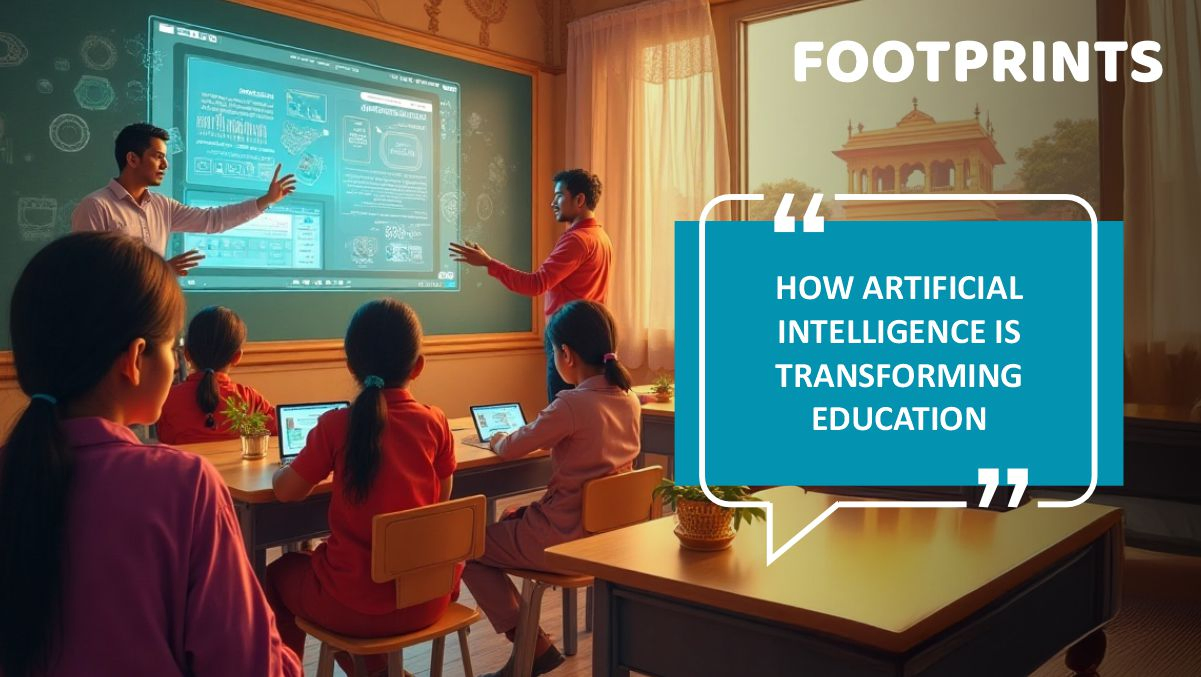

Having started as a futuristic concept, Artificial Intelligence is now all-pervasive. It has slowly but steadily seeped into all aspects of our lives. In fact, think of a typical day, and you are sure to find instances of how you are using AI tools in so many aspects of your life. The application of AI in real life spans healthcare diagnostics, personalized shopping, autonomous vehicles, and a lot more. Among others, education is a potent area that is being touched by AI, and how!
From personalized learning systems, intelligent tutoring systems, AI-driven classroom management, and more, Artificial Intelligence, when used wisely, is all set to improve education outcomes. At Footprints Education, we are witnessing how AI can support educators and enhance student engagement by offering data-driven insights, adaptive learning paths, and efficient classroom tools. Let us look at some of the many ways in which this new technology is not just impacting but transforming education.
How AI is transforming the Education landscape
1. Personalized Learning
AI is revolutionizing personalized learning by tailoring educational experiences to individual students’ needs, preferences, and learning styles. AI-driven systems can analyze students’ performance in real time and adjust the curriculum or difficulty level accordingly. It can recommend similar resources based on the students’ areas of interest to make learning more engaging. AI tools and artificial intelligence algorithms can also offer instant feedback to students and suggest areas of improvement. Chatbots and AI tutors can also be available 24/7 to solve any queries that students may face at any time.
2. Enhancing Learner Engagement
As opposed to traditional learning methods, AI is known to be more engaging. This is on account of the use of tools such as gamification, virtual and augmented reality, and interactive content. In fact, with AI, teaching does not remain a one-way dispensation of information. What AI ensures is that students participate in the learning process and remain engaged with it.
There are also enough and more artificial intelligence project ideas for students, ranging from building chatbots to AI-powered language translators and more, that students can try, at an age-appropriate level.

3. Improved accessibility
While there are still concerns of a digital divide in a country like India, as connectivity becomes more and more ubiquitous, AI continues to offer improved accessibility to students. This is showing up in various respects- whether it is students not having to rely upon the non-availability of teachers, in rural areas, for instance, or students with a disability, not being constrained by their inability to attend physical school.
4. Supporting teachers’ roles through augmentation
Shortage of qualified teachers is a pressing problem across the globe, as it is in India. AI is slowly but surely augmenting its role. It can streamline administrative tasks while teachers can spend meaningful time on student engagement. With a powerful combination of AI plus human teachers, a rich environment can be created that will benefit learners.
5. Refining assessment in education
AI is also playing a strong role when it comes to revolutionizing the assessment landscape. So far, we have relied on standardized tests to check student understanding of subjects. We all know that this system comes with a range of disadvantages. Such tests focus on prioritizing test preparation as opposed to meaningful learning and are known to cause a host of mental health issues for students. AI can help solve this problem as it supports non-standardized tests that are customized to each learner. Besides, educators can identify the strengths and weaknesses of each student and help them focus on their strengths as well as develop targeted instructional strategies.

6. Continuous Lifelong Learning
The way AI is also absolutely transforming the education landscape is how it supports continuous learning and professional development by catering to the tailored needs of each learner.
All of this is not to say that there are no attendance problems when it comes to the use of AI in education. For example, there can be algorithmic biases leading to unfair outcomes. Besides, the use of AI always comes with concerns about the attendant’s fears of data privacy. Over-reliance on technology, of course, is a whole discussion by itself. Lately, we are seeing many cases of how AI chatbots are being used by students for writing application essays, doing homework, and more, severely limiting their capacity to think.
While all of these are areas to be acknowledged, what is important to remember is that AI is only a tool, and its efficacy depends on how well we use it. We cannot live in denial and not acknowledge these problems. On the other hand, refusal to use AI on account of these problems alone will lead to a situation where we will very quickly be replaced by people who use AI to their advantage.
The idea for students is to begin with low-stakes tasks and then move on to the value chain using AI as not just a handy tool but also as a thought partner. Understanding and working with artificial intelligence while not succumbing to its problems is a task the entire education ecosystem needs to work on. It is the use of appropriate checks and balances that will make the adoption process smooth and relatively free of perils.For more information on such topics relevant to the future of education, do stay tuned to this space. At Footprints Education, we are deeply committed to the holistic growth of our students. We firmly believe that the right mix of tradition and modern tools need to be employed to ensure that children grow up to be individuals who have strong roots but equally are equipped with wings to fly high. Little surprise then that Footprints Preschool has emerged as the preferred parenting partner for parents across the country.
Shubham is an SEO expert dedicated to helping businesses to thrive in a digital landscape. His innovative marketing campaigns have significantly boosted the organization’s reach and engagement.

